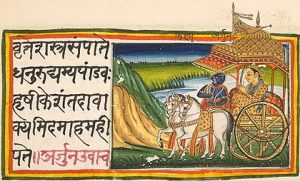Difference between revisions of "Language/Sanskrit/Grammar/How-to-Use-Be"
m (Quick edit) |
|||
| Line 108: | Line 108: | ||
* [[Language/Sanskrit/Grammar/Adjectives|Adjectives]] | * [[Language/Sanskrit/Grammar/Adjectives|Adjectives]] | ||
* [[Language/Sanskrit/Grammar/Pronouns|Pronouns]] | * [[Language/Sanskrit/Grammar/Pronouns|Pronouns]] | ||
<span class='maj'></span> | |||
==Sources== | |||
* [https://www.amazon.com/Higher-Sanskrit-Grammar-College-Students/dp/8120801784 A Higher Sanskrit Grammar: For The Use Of School And College ...] | |||
* [https://en.wikipedia.org/wiki/Sanskrit_grammar Sanskrit grammar - Wikipedia] | |||
* [https://www.mlbd.in/products/a-higher-sanskrit-grammar-for-the-use-of-school-and-college-students-revised-enlarged-9789394201217-9394201211-9789394201293-9394201297 A Higher Sanskrit Grammar: For the Use of School and College ...] | |||
{{Sanskrit-Page-Bottom}} | {{Sanskrit-Page-Bottom}} | ||
Revision as of 14:27, 12 March 2023
Hi Sanskrit learners! 😊
In this lesson, we will be discussing how to use the Sanskrit verb "be". This is a fundamental verb in any language and an essential part of Sanskrit grammar. We will learn its various conjugations, uses, and some interesting facts about it. So, let's dive in!
Introduction
The verb "be" is used to indicate a state of being. It can be used in various tenses, and its conjugation changes according to the subject and tense. In Sanskrit, the verb "be" is called "as" or "asti". It is an irregular verb and has a unique conjugation system. Understanding how to use "be" is crucial for mastering Sanskrit grammar.
Present tense
The present tense is a grammatical tense that is used to describe an ongoing action or a current state of being. In Sanskrit, the present tense has two forms for the verb "be" - "asti" and "bhavati". The form "asti" is used for the third-person singular subject (he/she/it), while "bhavati" is used for all other subjects.
To illustrate the usage of the present tense in Sanskrit, consider the following examples. In the table provided, the Sanskrit words are transliterated, and their pronunciation and English meanings are provided.
| Sanskrit | Pronunciation | English Meaning |
|---|---|---|
| अस्ति (asti) | asti | is (for third-person singular) |
| भवति (bhavati) | bhavati | are, am, is (for all other subjects) |
In a conversation between two people, the present tense is used to convey their current state of being. Person 1 says "त्वमस्ति (Tvamasti)" which means "You are", while Person 2 responds with "अहं भवामि (Ahambhavami)" which means "I am". These examples demonstrate the use of the present tense in Sanskrit, and how the two different forms of "be" are used based on the subject of the sentence.
Past tense
The past tense is used to describe an action that has already happened in the past. In Sanskrit, the past tense for "be" is "asit". Let's look at some examples:
| Sanskrit | Pronunciation | English |
|---|---|---|
| असित् (asit) | asit | was (for all subjects) |
Example dialogue:
- Person 1: त्वमसि (Tvamasi) (You were)
- Person 2: अहं अस्मि (Ahamasmi) (I was)
Note: "Asit" is the past participle form of the verb "as".
Future tense
The future tense is used to describe an action that will happen in the future. In Sanskrit, the future tense for "be" is "bhavishyati". Let's look at some examples:
| Sanskrit | Pronunciation | English |
|---|---|---|
| भविष्यति (bhavishyati) | bhavishyati | will be (for all subjects) |
Example dialogue:
- Person 1: त्वं भविष्यसि (Tvam bhavishyasi) (You will be)
- Person 2: मह्यं भविष्यति (Mahyam bhavishyati) (I will be)
Imperative mood
The imperative mood is used to give commands or make requests. In Sanskrit, the imperative form of "be" is "bhava". Let's look at some examples:
| Sanskrit | Pronunciation | English |
|---|---|---|
| भव (bhava) | bhava | be (for all subjects) |
Example dialogue:
- Person 1: भवतु (Bhavatu) (Be)
- Person 2: इदं सत्यम् (Idam satyam) (It is true)
Interesting facts
- Sanskrit has been used for over 3500 years, making it one of the oldest languages in the world. - The word "Sanskrit" means "perfected language". - Sanskrit is considered to be the mother of all Indo-European languages. - The Sanskrit alphabet has 49 letters, and each letter has a unique sound. - The famous Indian epics, Mahabharata and Ramayana, were written in Sanskrit.
To improve your Sanskrit Grammar, you can also use the Polyglot Club website. Find native speakers and ask them any questions!
➡ If you have any questions, please ask them in the comments section below.
➡ Feel free to edit this wiki page if you think it can be improved. 😎
Related Lessons
- Questions
- Gender
- Plurals
- Give your Opinion
- Future Tense
- Conditional Mood
- How to Use Have
- Adjectives
- Pronouns
Sources
- A Higher Sanskrit Grammar: For The Use Of School And College ...
- Sanskrit grammar - Wikipedia
- A Higher Sanskrit Grammar: For the Use of School and College ...
